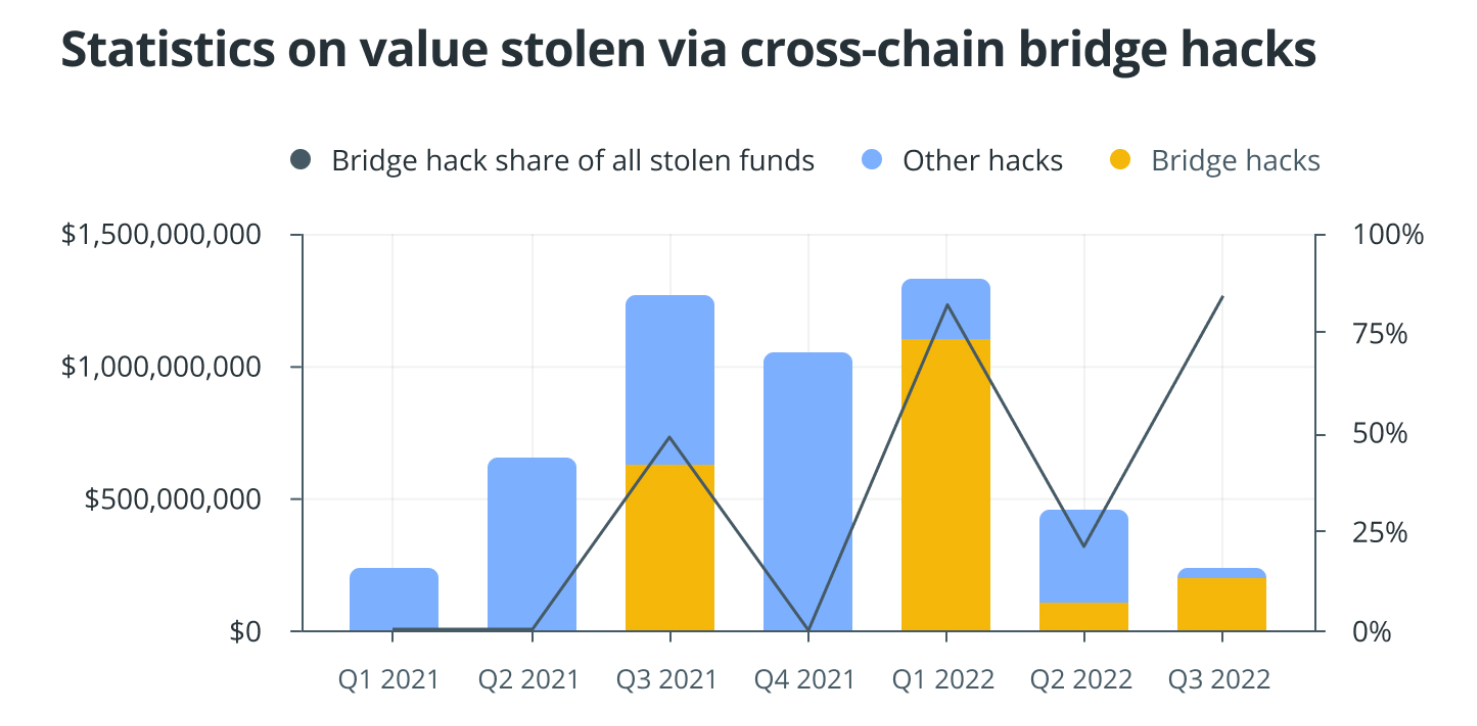The blockchain landscape can be compared to a bustling metropolis of independent networks, each with its own unique strengths and purposes. Bitcoin is known for its security, Ethereum boasts a robust smart contract ecosystem, and Solana stands out with incredibly high transaction speeds.
But what should a cryptocurrency user do if they want to seamlessly move assets between these networks? Decentralized finance (DeFi) shouldn’t be restricted to individual blockchains, and cross-chain bridges are ingenious software applications that ensure interoperability between different networks.
- History of Cross-Chain Bridges
- Risks Associated with Cross-Chain Bridges
- Mitigating Risks Associated with Cross-Chain Bridges
- The Utopia of Blockchain Interoperability

History of Cross-Chain Bridges
The concept of cross-chain bridges emerged in the early stages of blockchain technology. As early as 2016, projects like Plasma from Ethereum and Wanchain began exploring methods for transferring assets between different networks.
These early bridges were primitive and often relied on centralized custodians to hold assets during the transfer process. However, this approach contradicted the very nature of blockchain, which is meant to function in a trustless system.
As of March 2024, the cross-chain bridge space represents a thriving ecosystem with numerous projects vying for dominance. Notable examples include the widely used Multichain (formerly Poly Network), Wormhole, and the Inter-Blockchain Communication Protocol (IBC) from Cosmos.
Risks Associated with Cross-Chain Bridges
Between 2021 and 2022, more than $3.3 billion in crypto assets were lost due to hacks. Despite their immense utility, cross-chain bridges are not without risks. Bridges, along with smart contracts and oracles, constitute a significant portion of vulnerabilities in the blockchain ecosystem.
Statistics on Assets Stolen via Cross-Chain Bridge Hacks

Here are some of the key issues that continue to plague the development of this technology:
- Cybersecurity Vulnerabilities
Unfortunately, the very code that enables bridges to function also makes them susceptible to hacking attempts. Two high-profile exploits highlight this risk.
| Incident | Description |
|---|---|
| Ronin Bridge Hack | In 2022, hackers breached the Ronin Bridge, stealing over $600 million in cryptocurrency. The attack targeted a multisignature scheme using a private key, which ultimately proved to be insufficiently secure. |
| Wormhole Bridge Vulnerability | Earlier in 2022, the Wormhole bridge fell victim to a $325 million hack. The perpetrator exploited a vulnerability in the bridge's smart contract code, exposing a logical flaw in the system. |
These incidents underscore the critical need for thorough audits, secure coding practices, and robust bug bounty programs to strengthen bridges against potential attacks.
- Lack of Traceability
Unlike traditional financial systems, blockchain transactions can be pseudonymous. While this is a core principle of blockchain technology, such anonymity creates challenges when transferring assets between networks. Tracing the movement of illicit funds through bridges can be a difficult task for law enforcement and regulatory bodies.
This limitation of bridges can be used by hackers to anonymously move funds between blockchains, making it difficult for investigators to track them.
- Centralization Concerns
Over the years, and through the post-mortem of multiple hacks, several bridges have enhanced their decentralization. While some bridges operate in a decentralized manner, others remain more centralized, often creating a single point of failure and compromising the trustless nature of blockchain.
Mitigating Risks Associated with Cross-Chain Bridges
The blockchain community is actively exploring solutions to address the aforementioned risks. Here are some promising directions being pursued:
- Decentralized Bridge Architecture
Moving towards fully decentralized bridges, where governance and operation are distributed among a wider network of participants, can significantly enhance security and reduce reliance on trusted third parties.
The decentralized bridge network that makes up these bridges is incentivized through tokens. For instance, Wormhole recently announced its token program to incentivize its ecosystem.
- Formal Verification Techniques
Employing formal verification — a rigorous mathematical approach to proving the correctness of software code — can help identify and eliminate vulnerabilities within bridge smart contracts before deployment.
- Standardization and Interoperability
Standardizing communication protocols between bridges can foster seamless interoperability and potentially mitigate some traceability challenges. Projects like IBC are making strides in this direction. IBC enables secure, trustless communication and asset transfers between independent blockchains.

The Utopia of Blockchain Interoperability
The future of blockchain depends on interconnectedness. Cross-chain bridges are the key to creating a truly interoperable ecosystem where users can leverage the unique benefits of each blockchain without friction. As Web3 onboards billions of users, it should not matter to them on which blockchain their transactions occur.
Improvements Bridges Should Strive for in the Coming Years:
- Enhanced User Experience
Bridges should become more user-friendly, offering intuitive interfaces that simplify the asset transfer process even for non-technical users. To achieve this, the concepts of wallets, networks, and bridges need to be integrated into a more familiar functionality akin to Web2. For instance




